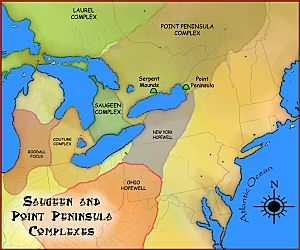Point Peninsula complex facts for kids

Point Peninsula and Saugeen complexes
|
|
| Period | Middle Woodland |
|---|---|
| Dates | 600 BCE – 700 CE |
The Point Peninsula complex was a group of early Native American people. They lived in what is now Ontario, Canada, and New York, USA. Their culture existed from about 600 BCE to 700 CE, during the Middle Woodland period.
Point Peninsula pottery first appeared in Canada around 600 BCE. It then spread south into parts of New England by 200 BCE. This new pottery was a big step forward in technology. It was much thinner, better fired, and had finer materials mixed in compared to older, thicker pottery. We don't know for sure where this new pottery style came from. These people were likely influenced by the Hopewell traditions from the Ohio River valley. This influence seemed to stop around 250 CE. After that, they no longer practiced special burial ceremonies.
Contents
Hopewell Trading Networks
The Hopewell exchange system was like a huge trading network. It started in the Ohio River and Illinois River valleys around 300 BCE. Hopewell wasn't just one single culture. It was more like a system where many different groups traded with each other.
Their trading routes were very wide. They traded obsidian from the Yellowstone area and copper from Lake Superior. They also traded shells from the Gulf Coast.
Burial Mounds and Special Items
Some Point Peninsula people buried their dead in special mounds. They placed unique items with the dead. These items included copper and silver pan pipes, shell necklaces, and special kinds of chert stone. Finding these special items in burials might mean that some people had higher status in their groups.
Pan pipes are a good example of Hopewell items. They have been found in burial mounds from Florida to Minnesota. These pipes suddenly appeared in North America around 200 BCE. Then, like other Hopewell items, they disappeared around 400 CE. Interestingly, nine pan pipes were found at the LeVesconte mound in Campbellford, Ontario. This is a Point Peninsula site. Even though the Hopewell trading system was mostly in the United States, much of the silver found in these items came from Cobalt, Ontario. This area is far up the Ottawa River.
Life of the Point Peninsula People
The Point Peninsula people of the Middle Woodland period got their food by hunting animals and gathering plants. They also started to farm a little. Around 900 CE, the types of artifacts found in New York changed. They were replaced by items from the Owasco culture.
Archaeologists believe that people from the Clemson Island culture moved north. They mixed with the Point Peninsula complex around the 1300s.
Owasco Culture and Farming
The Owasco people used different ways to make pottery. They also farmed more than the Point Peninsula people. They grew different kinds of maize (corn), squash, and later, beans. They lived in larger villages, with hundreds or even a thousand people.
There was often conflict among groups. Archaeology shows that people built villages with defenses. But many still died in violent ways. Over time, smaller groups and tribes joined together to form larger ones. The Owasco people are thought to have eventually become the Iroquoian-speaking nations. These nations lived in Pennsylvania and New York. The Haudenosaunee or Iroquois Confederacy likely formed to stop the constant fighting.
Important Sites
Some important sites for the Point Peninsula complex are in the Rice Lake/Lower Trent River area. These include the Serpent Mounds Park, Cameron's Point, and LeVescounte Mounds in Prince Edward County.
Serpent Mounds Park
The Serpent Mounds Park is located at Rice Lake. People lived there during the prehistoric Middle Woodland period. The burial mound there is shaped like a giant snake.

